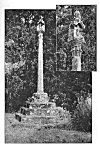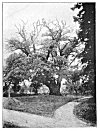
Click to enlarge
PLATE XI. CHURCHYARD CROSS.
Bitterley.
The ley and its sighting points were earlier than homesteads, hamlets, or towns, and as the latter evolved on the tracks, place names naturally bear traces of their origin.
It is no reflection on philologists that, not knowing of the ley, they have made misinterpretations, and have a huge mass of corrections to make. In particular they will find a past neglect in translating place names in the light of traders coming along the road and meeting

Click to enlarge
PLATE XI. CHURCHYARD CROSS.
Bitterley.

Click to enlarge
PLATE XII. TREE.
Eastwood Oak, Tarrington.
the buyers at settled points. The man who brought the long-coveted gold ornaments might only come once a year, but to the women of the community the Gold Hill, Gold Post, or Golden Cross (roads), where they met him, or the Golden Valley, along which he came, would be likely to take their names from his wares. There are two of each of. the above Gold place names in the county.
The notes which follow must be taken rather as suggestions than as final conclusions.
The common suffix--ley--indicates a ley of the character denoted by the first element in the name, and "meadow" is not, I think, the right interpretation. The numerous Leys Hills are not likely to be so called from meadows.
The suffix--ton originated by a mark stone on the ley becoming the nucleus of a homestead, and perhaps later a town.
The suffix--bury clearly indicates a mound which was a sighting tump. It is a strange development that these tumps were coveted both as places to be buried in and to live on. Mrs. Gillespie (who lived at Trewyn, Pandy, for 17 years) writes me: "I suppose you know that Trewyn was built on a burial mound," and goes on to describe the discovery of a cist with human remains which they dug up under one of the rooms. I had told her how Trewyn was on two leys (therefore on a sighting point), one being down the avenue of ancient pine trees straight for Alt-y-Ynis.
Barrow (another mound name) occurs at Cradley, Pembridge, and Wheelbarrow Castle, Leominster; Canon Bannister shows that Coldborough was formerly Colbarwe, and he also associates borough and bury as from the same root. A variation is berrow as in Broomsberrow. Just as the sighting stone--ton became the site of our modem town, so the mound evolved into the borough.
Low--the universal name for the mound in Derbyshire--is not so common here. But Wormlow Tump, Ludlow, Warslow, and Bradlow indicate sighting points.
Bury is used alone as the name for a tump, as in the many Bury Farms, or as at Ivington Bury. A farmer still calls the earth covered tump in which he winters his roots a bury. Towns like Ledbury first grew round a sighting mound.
"Broom" occurs with great persistence on leys, with its variations brom and bram. Bromley and Bramley, Bromton and Bramton, Bromfield (where is the Old Field with a number of tumuli), Broomsgreen, Broomsberrow, and the many Broomy Hills are examples. It is not confined to one form of sighting point, and I surmise (from
a faint line of evidence) that a component part of our modern broom was an essential working implement of the skilled ley man, and was continued as the staff of the mediæval pilgrim. Whether the plant broom was the original root word or a derivative I cannot say.
Lady Lift (a hill-point mound) is on a ley with Lady Harbour Farm, and the prefix Lady is applied to court, grove, ridge, oak, and meadow in the county. The Lady Harbour of Hereford Cathedral is on one of the leys which form Church Street, and had the name before any church was built there. It might possibly indicate a woman's shelter on the road.
The suffix--tree, probably originated in a single tree planted as a sighting point, either as at "Cross of the Tree" in Deerfold Forest, or to mark the apex of a natural hill as illustrated in Plate XII. Webtree is on such a hill with two leys passing through it. Its name signifies that it is the spot where the webbe or weaver met his buyers. He travelled along the webbe-ley, and there are three Weobleys (formerly Webbeley) in the county, at Weobley Ash, and Weobley Cross, also the better known townlet. He also met others at a mark stone now known as Webton. The surnames Webb, Webber, and Webster still survive.
In the same way another first word element gave the place names (and surnames from them) of Bosley (Cattle-ley), Boston, Bosbury, Boswell, Bostock, and Boscastle. Again, Stanley, Stanwell, Stanton, Stanbury, and Stanbatch. And I have shown how the white (salt) man gave the first element to innumerable place names on his route. There is a Silver Tump and a Brass Knoll in the Olchon Valley, both proved sighting tumps.
The names Bowley, Bowling Green (farm, also a quarry Dear Ewias Harold), Bolitree, Bolstone, Bollingham, Bal Mawr, Balls Cross, Ballgate, Bellgate, Bellimore, and Belmont, all seem akin to the rounded outline of an inverted bowl, or to boils, bowels, and belly of animal life, and indicate the rounded tump.
The house at Bolitree is built on a tump with signs of a moat, and as I found a ley through Bollingham (house and chapel) I went there to find the bol, and there it was, a fine tump with an old summerhouse on its summit.
Gate in a place name (as in Hill Gate, Three Gates, Ballgate, England's Gate, Burley Gate, etc.) did not mean, as now, something which stopped a way (that was called a lid-yatt), but the way itself. It is much the same as the word pass. The same element (modified) is in such names as Gatley, Gatsford, Yatton, Symonds Yat, Woodyatt's Cross.
Lee Line and Timberline Wood are place names clearly describing leys. There is a Linton and a Linley at Stanford Bishop--the mark stone and the ley. I think that Lyonshall, Lynhales, Lion Farm, and Hobby Lyons are variations.
Such names as Winslow, Preston Wynne, Winsley, and Winyard (Radnor Forest) indicate the road by which wine was brought. Totnor, Totteridge, Tothill, and Twt indicate (as Mr. J. G. Wood has pointed out) tumps, and they are all sighting tumps on leys. Mr. Wood (who has come very near discovering the ley) also--in Woolhope Transactions for 1919--connects Titterstone, Clee Hill (Plate I.) with the word Tot or Toot. Tooting and Tottenham are London forms of the word. Rosemary Topping (English Bicknor) is a much prettier name for a sighting tump.
Bur or Burl seems to be descriptive of some form of sighting point. Leys pass through Burley, Burlton, Burton (many of this name), Burford, and The Burcot; and there is a Burl Hill in Radnorshire.
Although a ley ran from peak to peak there must have been an earlier termination to its useful part, or a still more restricted part used by traders. Hence--in London--Finsbury; Capel-y-fin in the Black Mountains; and Fine Street, near Letton, have probably the same meaning, which, however, seems to be locally more often expressed by the word end, as in New End (Canon Pyon), Red Wych End (Cowarne), Nupend, etc.
As regards the place name element "broad" (also brad and bred), a ley passes through Broad Green (Orleton), The Broad, north of Leominster, Broadward, south of Leominster (dead on the main road at each of these two), and on to Broadlands at Aylestone Hill, Hereford. It was the road, not the place, which was broad, constructed for wheel traffic, for which the previous pack-horse tracks were too narrow. Mr. Allan Bright, of Barton Court, Colwall, wrote me, pointing out that a ley from the Wych through his house to Ledbury Church, also ran through a meadow of his called Broadley Meadow. Such names as Bradley, Bradlow, Bradford, Broadmoor, Broad Oak, and Bredwardine are thus explained.
Probably most instances of the word elements, little and long, apply to the roads which pass through the places. Hereford is (no doubt correctly) said to mean "army road." Little Hereford is not a small edition of the town, but of the road. Litley is the small ley, Longley is the long ley, and so with the stone, grove, land, and ford
[paragraph continues] (there have been two Longfords). Long in old spelling was often lange; and little, lutel or luttel--these from Canon Bannister's list. Hence come the (places and surnames) Langstone, Langford, Langland, Langton, Lutley, Luton. The two Leinthalls--Earles and Starkes--are seldom called by these second names locally, but are Little Leinthall and Long Leinthall respectively, the element leint (occurring also in Leintwardine) being I surmise derived from ley. Little Leynthale, to quote an old spelling, would be the meadow traversed by the short ley.